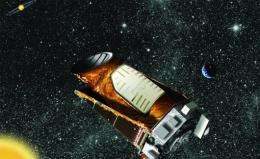(PhysOrg.com) -- An astronomer at the University of St Andrews will use a powerful planet-hunting telescope to find out the true size of the Universe.
Researcher Dr Alan Penny will use the brightness of half a dozen stars to refine estimates of how big the Universe actually is. Dr Penny hopes to solve the problem using the 'extreme precision' of NASA's Kepler satellite launched into space last month.
Developed for the search for new planets, Kepler's main task is to look for planets by monitoring the brightness of 100,000 stars. But Dr Penny, a member of a 200 strong international team, will use the same data to study a much smaller sample of stars.
He explained, "While Kepler is doing its exciting planet-hunting, we will be using its extreme precision to resolve a possible problem with our measurement of the size of the Universe.
"These variable stars known as 'Cepheids' form the base of a series of steps by which we measure the distance to distant galaxies and, through them, we can measure the size of the Universe".
Since it is likely that scientists' understanding of how these stars vary in brightness is incomplete, Dr Penny will use the six stars as a basic yardstick to work out how much previous estimates of the size of the Universe are wrong. He believes that current estimates of the size of the Universe, at 93 billion light years across, might change up to a few percent.
He explained, "These Cepheid stars which get brighter and fainter by some tens of percent every ten to a hundred days are mostly understood. But recently it has become clear that our theories of what happens in the outer layers of these stars which cause the variations in brightness do not totally agree with what we see.
"The exquisite accuracy of Kepler in measuring star brightness, one hundred times better than we can do from the ground, means we can get such good measurements that we should be able to match theory with observation. Resolving the issue may only change estimates of the size of the Universe by a small amount, but we won't rest easy until the problem is solved," concluded Dr Penny.
Provided by University of St Andrews
























